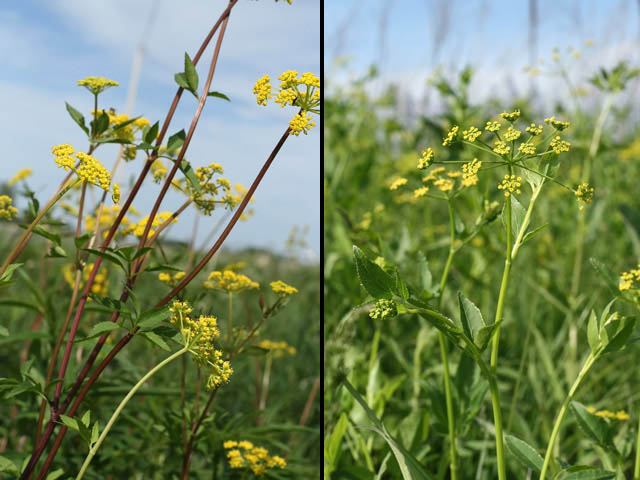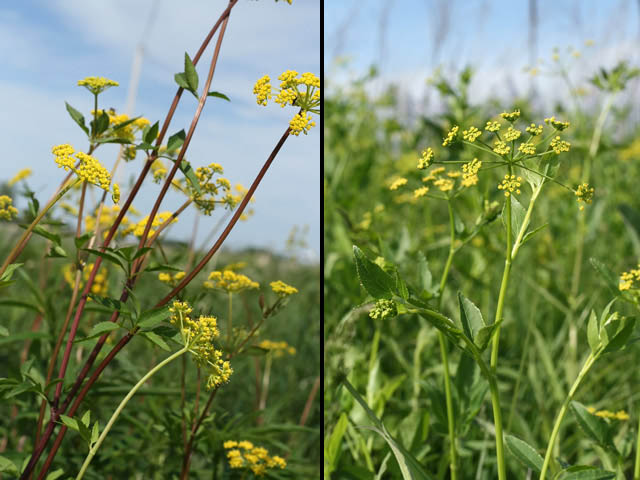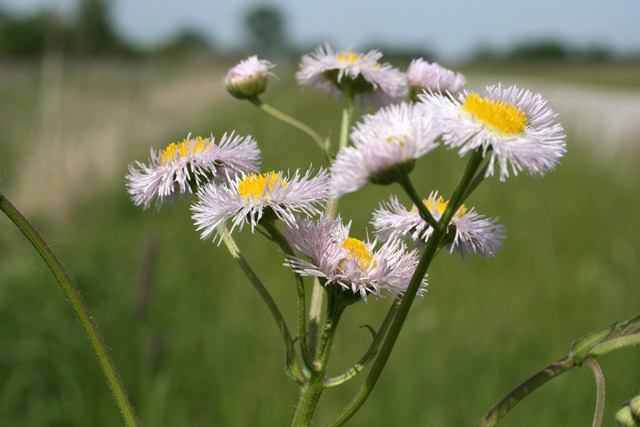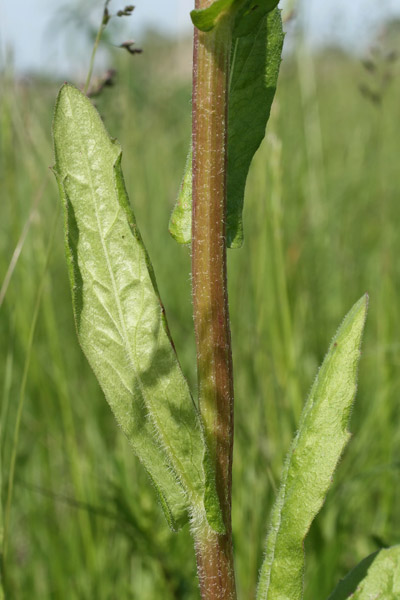Claridon Railroad Prairie: A Tale of Two Umbellifers
Meadow parsnip, Thaspium trifoliatum, is a challenging species to identify. It’s remarkably similar to another, more common, prairie plant that also is a medium-sized, yellow-flowered, spring-flowering member of the carrot family (Apiaceae), the lovely golden Alexanders, Zizia aurea.
The Apiaceae is a very distinctive plant family. It is named after the genus Apium, which includes celery, A. graveolens. The Apiaceae used to be called the “Umbelliferae,” meaning “umbel-bearing,” because the flowers are usually borne in distinctive radiating clusters called umbels within which the flowers are individually stalked and attached all at the same point on the flowering stem. Queen-Anne’s lace and poison hemlock are familiar wild examples, while dill-weed, carrot and parsley are found in the garden. Other distinguishing Apiaceae traits are compound leaves with a base that sheaths the stem, and tiny flowers that have an inferior ovary that develops into a unique fruit type called a “schizocarp” that separates into two individual one-seeded units. Some familiar spices –dill “seed,” and caraway “seed” –are from this family. (Being a portion of fruit containing a seed, these spices technically are not seeds, although in nature they function as such.)
Nowadays, all plant families name start with the prominent genus in that family and end in “-aceae” (pronounded “ai-seh-ee”). Older books, however, designated a few families by names that don’t have “-aceae” endings. There are 8 of them, mostly very large families with some singular distinctive trait. People (old people, anyhow) still refer to “crucifers” in reference to the traditional name of the mustard family, Cruciferae (nowadays called Brassicaceae), and “composites” for the aster family, Asteraceae.

Claridon Railroad Prairie
Marion County, OH, May 29, 2008
Claridon Railroad Prairie is a diverse prairie remnant of the Sandusky Plains. The prairie is one mile long and 50 feet wide, situated between an active CSX railroad track and a little-used county Road in Marion County, OH. It was the inspiration and primary seed source for the Larry R. Yoder Prairie, a prairie restoration at OSU’s Marion Campus. Both similar umbelliferous species occur at Claridon, and they are flowering now.

Two simlar umbellifers
Left: golden Alexanders (Zizia aurea), Right: meadow parsnip (Thaspium trifoliatum)
Claridon Railroad Prairie, Marion County, OH, May 29, 2008

Leaves of two simlar umbellifers
Left: golden Alexanders (Zizia aurea), Right: meadow parsnip (Thaspium trifoliatum)
Claridon Railroad Prairie, Marion County, OH, May 29, 2008
In a standard botanical reference manual, the genera Zizia and Thaspium end up alongside ea ch other, separated by details of the inflorescence and the ovary. (Note that the Zizia leaf specimen above has five leaflets although it’s supposed to have only three. Evidently the plant didn’t read the book.)

Both diagnostic traits can be discerned when the plants are either flowering or fruiting, although the ovary-is-winged feature, subtle in flower, is very conspicuous in fruit. The central flower, and only the central flower, of Zizia is sessile (stalkless), while all the flowers of Thaspium are stalked. Note also the prominently winged ovary (lower portion of epigynous flowers such as these) is winged in the Thaspium.

Partly dissected umbellets of two similar yellow-flowered prairie umbellifers
Zizia is on the left and Thaspium is on the right.
A few flowers were cut off from the foreground region of each cluster to reveal the central flowers.
Claridon Prairie, May 30, 2008
There’s a massive display of white blue-eyed grass at the west end of the prairie. This species, Sisyrinchium albidum (family Iridaceae) was noted two weeks ago at the Marion Campus Prairie, where only one plant was seen and it had a distinct bluish cast to the flowers. Flower color can vary, and albino forms of many plants that are normally pink or blue-flowered occur now and then. This raised the question, “Are you sure this is white blue-eyed grass and not just a nearly albino form of a more common species?” (S. angustifolium is the common Ohio species of blue-eyed grass.) Generally when similar species differ by flower color, there are other differences as well, and that’s true in this case: E. Lucy Braun in Monocots of Ohio tell us that S. albidum spathes (paired leaf-like appendages from which the flowers arise) are stalkless, whereas the spathes of S. angustifolium are stalked. She also mentions that the flowers of S. albidum, which are normally white, can also be blue. That would be “blue white blue-eyed grass”!

Sisyrinchium albidum (family Iridaceae), Claridon Railroad Prairie, Marion County, OH, May 30, 2008.
The fleabanes (genus Erigeron in the family Asteraceae) are native annuals, biennials or short-lived perennials. They resemble asters (Symphyotrichum) but are generally spring-flowering whereas the asters bloom in late summer and fall. I’m not sure of the species, but I think that the one with clasping leaves, which this seems to have, is the Philadelphia fleabane, Erigeron philadelphicus.

Erigeron philadelphicus at Claridon, May 29, 2008

Erigeron philadelphicus leaves
